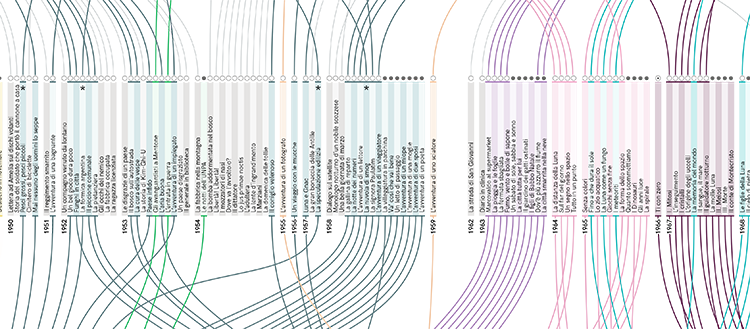Italo Calvino reborn in the digital age
Italo Calvino is amongst the most famous Italian authors of the 20th century. A team of researchers from UNIGE and the Politecnico di Milano cast a new light on his work, using advanced data visualization techniques.
One of the visualizations proposed by the Atlante Calvino project traces the editorial history of the author’s 200 or so stories, from their first publication in a newspaper or journal to their publication in collections, allowing us to follow the flows and changes that take place over time.
The project «Atlante Calvino, literature and visualization» explores new methods of literary analysis by combining writing and image. It is led by an international and multidisciplinary group of researchers, in which a literary team from the University of Geneva (UNIGE), Switzerland, collaborates with the graphic designers and computer scientists of the Politecnico di Milano, specialized in Digital Humanities and the visual representation of complex problems. The first phase of this project, supported by the Swiss National Science Foundation (SNSF) has allowed for the production of four interactive visualizations of Calvino’s work: a table of all his writings organized by decade, a second one presenting the entirety of his stories and their editorial history, a scatter plot listing the thousands of people he quotes and finally a timeline showing the dates of writing and those, often different, of publication. Ultimately, all these findings will be published on a web platform allowing anyone to discover Calvino’s work.
“Some things, rather than being described, could be shown. The visual medium and the literary tool are not antagonistic and the text-image alliance is old: the Encyclopedia of the Enlightenment already combines them, with the conviction that cognitive acquisition also involves images,” notes Francesca Serra, Professor in the Department of Romance Languages and Literatures at the UNIGE Faculty of Humanities, who leads the Atlante Calvino project. This experimental project was launched in September 2017. It aims to establish a new kind of dialogue between literary and technical experts, “with no preconceived conclusions about its outcome,” says Francesca Serra. Her literary team had to comply with the requirement for a precise, almost binary definition of the concepts they handle in order to allow for data management methods. “And when this was not possible, our technicians had to find a way to represent this uncertainty,» explains Paolo Ciuccarelli, director of the DensityDesign at the Milan Politecnico.
From study to model and back
Both teams were thus able to lay the foundations of the project: the data provided by Francesca Serra’s team enabled the Italian technicians to develop four models, which in turn can become the subject of further studies by the literary researchers, opening up new fields of critical analysis. For example, the review of all the names mentioned in Italo Calvino’s essays provides new insights into the author’s cultural references and how they have evolved over time. This tool is not a directory, but rather a highlight of the networks and interactions that exist between all the author’s cultural references. Researchers can thus group and analyze the data according to the fields of interest to them: highlight all references to the 19th century or all the painters cited by Calvino, regardless of the period to which they belong.
With more than 200 stories and about 20 books translated worldwide, Italo Calvino is amongst the leading Italian writers of the 20th century. In the 1950s, he joined Palmiro Togliatti’s Communist Party and took part in the Italian political life. Throughout his forty-year long career, he explored various forms of literature, ventured into the fields of science, anthropology and culture in the broadest sense, capturing its evolution into the Paris of the 1960s where he lived. His work is written in an accessible and sophisticated language and mixes comedy with philosophy, as shown for instance in his trilogy Our Ancestors, which features a viscount cut in two, divided between good and evil, a baron who spends his whole life in trees and a knight who only exists under his empty armour.
Go beyond quantitative analysis
“The quantitative data highlighted by the first stage of our project are interesting, but our ambition is greater and goes beyond quantitative analysis. We are looking for the framework behind the motif, the way in which the work is organised and structured,” Francesca Serra emphasises. The UNIGE researchers are now addressing complex questions, such as the theme of doubt in the author’s work, which is highlighted by its recurring reference to fog, or that of metamorphosis, illustrated by the many cities that dot Calvino’s work, some of which are real and others not.
10 Oct 2018

